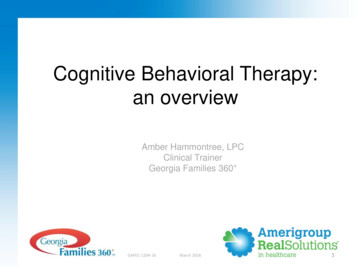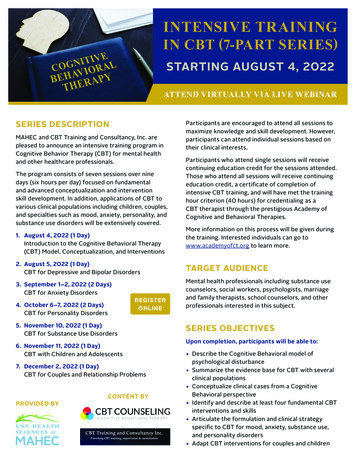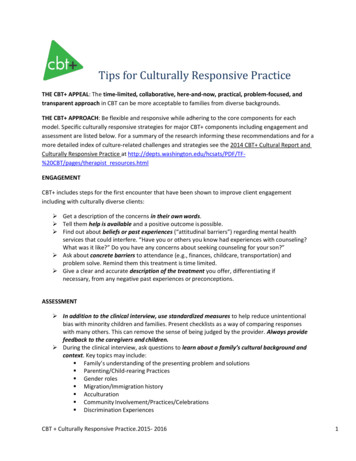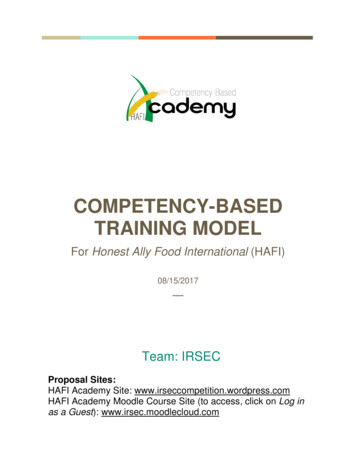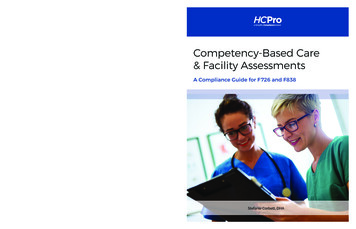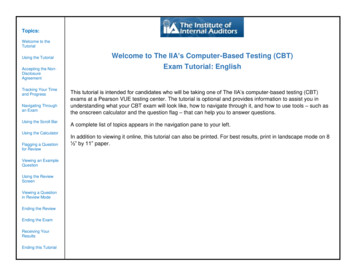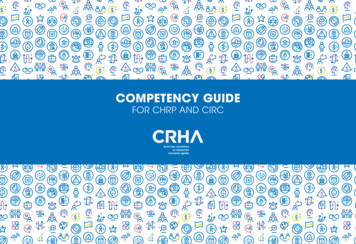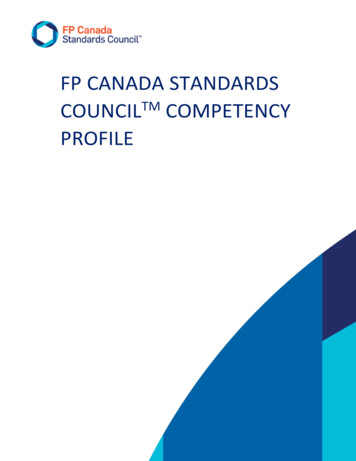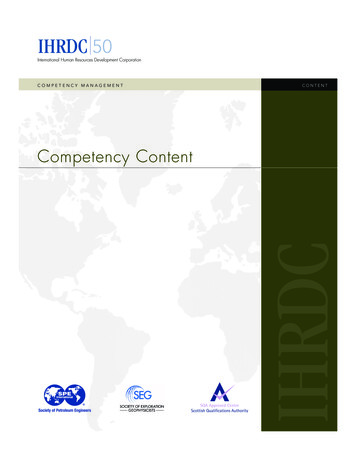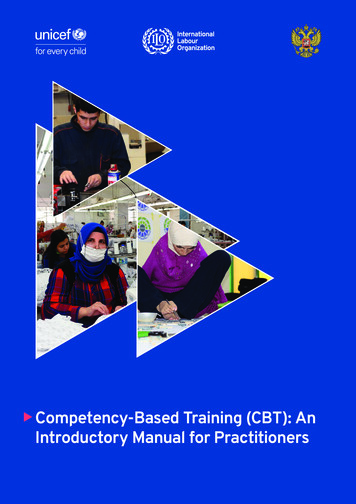
Transcription
XXCompetency-Based Training (CBT): AnIntroductory Manual for Practitioners
Copyright International Labour Organization 2020First published 2020Publications of the International Labour Office enjoy copyright under Protocol 2 of the Universal CopyrightConvention. Nevertheless, short excerpts from them may be reproduced without authorization, on condition thatthe source is indicated. For rights of reproduction or translation, application should be made to ILO Publishing(Rights and Licensing), International Labour Office, CH-1211 Geneva 22, Switzerland, or by email: rights@ilo.org.The International Labour Office welcomes such applications.Libraries, institutions and other users registered with a reproduction rights organization may make copies inaccordance with the licences issued to them for this purpose. Visit www.ifrro.org to find the reproduction rightsorganization in your country.Main title: Competency-Based Training (CBT): An Introductory Manual for PractitionersISBN: 9789220330319 (Print)Also available in [Arabic]: Competency-Based Training (CBT): An Introductory Manual for Practitioners, ISBN[9789220330319 (Print)]The designations employed in ILO publications, which are in conformity with United Nations practice, andthe presentation of material therein do not imply the expression of any opinion whatsoever on the part of theInternational Labour Office concerning the legal status of any country, area or territory or of its authorities, orconcerning the delimitation of its frontiers.The responsibility for opinions expressed in signed articles, studies and other contributions rests solely with theirauthors, and publication does not constitute an endorsement by the International Labour Office of the opinionsexpressed in them.Reference to names of firms and commercial products and processes does not imply their endorsement by theInternational Labour Office, and any failure to mention a particular firm, commercial product or process is not asign of disapproval.Information on ILO publications and digital products can be found at: www.ilo.org/publns.Printed in Jordan
XX22Competency-Based Training(CBT): An Introductory Manualfor Practitioners
ForewordAs companies, training providers and skills development systems are challenged to improve(future) workers’ skills, the competency-based training (CBT) approach to technical and vocationaleducation and training (TVET) has been recognized as a highly effective way of ensuring that trainingprogrammes remain relevant to the labour market.The CBT approach is demand-driven, and focuses on the skills and competencies that a learner candemonstrate – in a practical way – for a given occupation. CBT is particularly relevant to the futureof work, where workers will continue to learn throughout their careers in a modular approach. It isof crucial importance that the competencies resulting from this continuous training are signalled,acknowledged and then matched to specific responsibilities, while being adequately valued.Even though CBT has sometimes been included in TVET programmes in the region, it has not yetbeen fully integrated in a systematic and comprehensive way into the entire training programmecycle. This training manual aims to address this shortcoming, and is the first of its kind in the region toprovide TVET trainers and developers with a basic understanding of the steps involved in designinga competency-based programme. It shows how to implement such a programme, measure its impactand update it.I hope that this manual will find a practical application in the Arab region and contribute towards theprogressive reform of the TVET system, while helping to reduce skills mismatches and improve thelabour market. As new evidence and findings emerge on the implementation and outcomes of theCBT approach in the region, it is anticipated that revised versions of this manual will be released inthe coming years.Ruba Jaradat,Regional DirectorILO Regional Office for Arab States3
AcknowledgementsThis manual was devised under the auspices of the ‘Applying the G20 Training Strategy Project:A Partnership between the Russian Federation and the ILO.’ The document was developed byMr. Patrick Daru (ILO Skills & Employability Specialist for the Arab States) and Mr. Yasser Ali (ILOConsultant). The manual has benefited from inputs by Ms. Dahlia Roque (ILO Consultant), Ms.Rania Hokayem (Project Officer at the ILO Regional Office for the Arab States), Ms. Eman Alaraj(ILO Project Coordinator), Mr. Ahmad Al Badareen (National Project Officer), Mr. Paul Comyn (ILOSenior Skills & Employability Specialist) and Ms. Christine Hofmann (ILO Skills & EmployabilitySpecialist). The final document builds on an initial draft that was prepared by Dr. John Knapp (ILOConsultant) and Mr. Yasser Ali under funding from UNICEF.The text also draws on number of prior publications by the ILO, including:ILO. 2013. Inclusion of People with Disabilities in Vocational Training: A practical ces/WCMS 230732/lang--en/index.htm.ILO. 2015. Manual on Skills Testing and Certification: S 358358/lang--en/index.htm.ILO. 2016. Compendium on Skills Needs do/Projects/WCMS 534345/lang--en/index.htm).ILO. 2019. Guidelines for Non-Formal Market-Based Skills Training in MS 666243/lang--en/index.htm.44
Table of 9Glossary.10Introduction – Understanding CBT.12Additional readings.161: Identifying priority occupations.17Step 1: Skills needs assessment.17Step 2: Training needs analysis.24Additional readings.242: Identifying competencies.26Step 3: Identifying competencies using occupational analysis.26Step 4: Verifying the occupational profile.31Step 5: Developing competency standards.32Additional readings.333. Developing competency-based training programmes.34Step 6: Defining the curriculum . .34Step 7: Developing learning tools (learner guides, job sheets and lesson plans).38Step 8: Designing CBT for workplace-based learning.41Additional readings.434. Delivering, assessing and certifying learners in cbt programmes.44Step 9: Managing the administrative aspects of CBT.44Step 10: Implementing effective learning strategies for CBT.47Step 11: Managing the learning process (classroom management).53Step 12: Understanding and designing assessments.58Step 13: Conducting final assessments and certifying learners.75Additional readings.805
5. Keeping CBT programmes relevant.81Step 14: Monitoring and evaluating CBT.81Step 15: Conducting a programme validation study.83Step 16: Undertaking graduate tracer studies and employer satisfaction surveys.84Additional readings.85Conclusion and next steps.86Appendix.88Step 3: Identifying competencies using an occupational analysis .88Step 4: Developing a competency profile.89Step 5: Setting competency standards.90Step 6: Defining the curriculum .92Step 11: Implementing effective learning for CBT.93Step 12: Understanding and designing assessments.97Step 13: Conducting final assessments and certifying learners.114Step 14: Monitoring and evaluating CBT.116Step 16: Undertaking graduate tracer studies and employer satisfaction surveys.117Bibliography.11866
List of tablesTable 1. Benefits of the CBT approach for employers and trainees.14Table 2. Common findings of a skills needs assessment and some corresponding solutions.19Table 3. Potential approaches for a skills needs assessment.20Table 4. Various methods for undertaking a skills needs assessment.22Table 5. Some duties and tasks for the occupation of “auto mechanic”.27Table 6. Methods of assessing the competencies required for a training programme.28Table 7. Part of an auto mechanic’s competency verification results.31Table 8. Elements to consider when defining a curriculum framework .34Table 9. Template of an auto mechanics module design.36Table 10. Parts of an auto repair course structure.37Table 11. Example of workplace learning strategies – auto mechanic wheel alignmentprocedure . .41Table 12. CBT pre-course checklist.44Table 13. Considerations for preparing an inclusive training programme.45Table 14. Considerations for training accommodation.46Table 15. Adult learning – implications for CBT sessions.48Table 16. Examples of learning modalities.49Table 17. Considerations for different learning styles in CBT sessions.49Table 18. Examples of active learning strategies.50Table 19. Tools for instruction and regular assessment of competencies.52Table 20. Key techniques for active listening.53Table 21. Four key question types.54Table 22. The LEAST approach to classroom management.55Table 23. A three-step approach to handling complaints.57Table 24. Common assessment strategies.59Table 25. Comparisons of theoretical knowledge assessment items.61Table 26. Comparisons between the most common practical assessment methods.637
Table 27. Checklist example.67Table 28. Rating scale example.67Table 29. Rubrics assessment example.68Table 30. Good qualifiers for assessment.69Table 31. Evidence matrix example.70Table 32. Example of a practice test form.74Table 33. Example of an assessment review form.78Table 34. Information obtained from various monitoring methods.82Table 35. Primary tasks for a graduate tracer study or an employer satisfaction survey.85List of figuresChart 1. Three markets to be considered in a skills gap analysis.18Chart 2. DACUM analysis key steps.29Chart 3. Part of an occupational profile for auto repair (DACUM chart).30Chart 4. Steps to developing competency standards.33Chart 5. Job sheet example.39Chart 6. Example of a lesson plan.40Chart 7. Tree diagram on assessment methods.6688
AbbreviationsCBTCompetency-based trainingCUDBASCurriculum development based on vocational ability structureDACUMDeveloping a curriculumGACGeneral area of competenceILOInternational Labour OrganizationOJTOn-the-job trainingOSHOccupational safety and healthPESPublic Employment ServicesPLARPrior learning assessment and recognitionRPLRecognition of prior learningTVETTechnical and vocational education and trainingWBLWorkplace-based learning9
GlossaryAdult learningAdult learning (andragogy) includes those processes and practices specific toadults gaining knowledge or expertise, based on self-directed learning.AssessmentsA systematic process of measuring/evaluating and documenting an individual orgroup’s level of knowledge, skills and attitudes.AssessmentevidenceThe information gathered during the assessment process that determineswhether an individual or group is competent. In CBT assessments, evidence isdirectly linked to the demonstration of competence and the ability of the trainee toperform to a certain standard.CompetencyThe demonstrated ability to apply knowledge, skills and attitudes in order tosuccessfully complete work activities to a defined standard of performance, asexpected in a real-life workplace environment.Competencybased training(CBT)CBT is a structured training and assessment system that allows individuals toacquire skills and knowledge in order to perform work activities to a specifiedstandard.CompetencystandardCompetency standards are benchmarks to assess the knowledge, skills andattitudes required by an individual in order to perform in the workplace. Thesebenchmarks are combined together to form units of competencies.DACUMDeveloping a curriculum is a quick and cost-effective method of occupationalanalysis that uses a focus group to facilitate a storyboarding process in order toconduct a thorough analysis of a given occupation.Delphi methodThe Delphi method involves a questionnaire sent to a group of experts over severalrounds. After each round, anonymous responses are aggregated and shared withother experts, who are allowed to adjust their responses. The process continuesuntil the group believes they have reached consensus.Learner-centredapproachlearner-centred approach, principles, practices, assessment, etc. are all aboutorganizing teaching, learning and assessment based on the learner’s personalcharacteristics, needs and interests. (see riculum-terminology ). It changes the learning experiencefrom one where the learner is a passive recipient of the knowledge dispensedby the instructor, to one where they take an active part in the learning process,and the instructor’s role is only to facilitate the process. This approach guideseducational reform at all levels.NationalqualificationsframeworkA formal national structure for classifying qualifications by level, based on learningoutcomes and descriptors.On-the-jobtraining (OJT) andworkplace-basedlearning (WBL)WBL refers to learning that occurs when workers, including apprentices, producereal goods and services. OJT refers to training undertaken at the workplace aspart of practical training provided by technical and vocational education andtraining (TVET) or other educational institutions.1010
Self-directedlearningSelf-directed learning is when students initiate their own learning process byidentifying their learning needs, goals and strategies, and evaluating their learningoutcomes.Standard detailedtask analysisA process to analyse tasks by breaking them into elements that help identifyperformance steps and standards, the tools and equipment needed, relatedknowledge, safety and health information, etc., in order to develop instructionalmaterials.SWOT analysisA rapid analysis undertaken to identify strengths, weaknesses, opportunities andthreats (SWOT).Units ofcompetencyEach unit of competency identifies workplace requirements, as well as theknowledge and skills of the competency (including language, literacy andnumeracy).TVET institutionsTVET institutions or providers include TVET schools, TVET colleges, TVETinstitutes, and TVET centres, together with national, local, and sectoral bodiesand councils for TVET.11
Introduction: Understanding CBTTHE OVERALL PURPOSE OF THIS MANUAL IS TO PROVIDE GUIDANCE TO TVET DEVELOPERS,TVET ADMINISTRATORS AND INSTRUCTORS ON THE DESIGN, DELIVERY AND ASSESSMENT OFCOMPETENCY-BASED TRAINING (CBT) PROGRAMMES. The manual encompasses the minimumknowledge that practitioners should possess on delivering CBT for lower- to mid-level skilled occupations.Efforts have been made to ensure that the manual is relevant to the Arab states. Some parts (e.g. on adultlearning and the learner-centred approach) are not specific to CBT, but are required for the successfulimplementation of a CBT programme. Also, there are many national versions of CBT – the intention here isto focus on the core elements of a lower-skilled competency-based programme without giving preference toany national model. The main parts of the manual include:understanding key CBT concepts;conducting labour market and skills-gap analyses;identifying the competency requirements of an occupation;translating the required competencies into a CBT programme or curriculum;implementing CBT programmes into TVET institutions and the workplace;assessing CBT efficiently;validating CBT programmes.COMPETENCE IS A COMPLEX CONCEPT WITH MANY DEFINITIONS. For the purpose of this manual,a competency is defined as the demonstrated ability to apply knowledge, skills and attitudes in order tosuccessfully complete work activities to a defined standard of performance, as expected in a real-lifeworkplace environment. Under this definition, knowledge is defined as possessing the required informationfor a task 1. Skills are the ability to carry out a task with pre-defined results, often within a given amount of timewith limited energy. An attitude is the stance or approach undertaken by an individual towards a certain idea,object, person, or situation, as conditioned by their system of principles, beliefs and habits. Competenciesare classified into: (a) technical/professional competencies; and (b) transversal/general competencies (skillsand attitudes the individual is expected to display while performing tasks), which are also coined as life skills/core work skills/soft skills/employability skills, etc. They are important for specific occupations, but also forstrengthening labour mobility.2CBT IS A STRUCTURED TRAINING AND ASSESSMENT APPROACH THAT ALLOWS INDIVIDUALSTO ACQUIRE THE SKILLS AND KNOWLEDGE TO PERFORM SIMPLE OR COMPLEX TASKS TO ASPECIFIED STANDARD. CBT is focused on: (1) the performance of tasks and duties by an individual; (2)the conditions in which they are to perform these tasks and duties; and (3) the standard to which they areto perform. CBT is an outcome-based learning system for developing curricula. Training and assessment is1 Knowledge is further classified between declarative and tacit knowledge, and one of the roles of the instructor is to identify the tacitknowledge and make it explicit.2 See the list of additional readings at the end of this chapter for the MENA region’s life skills framework.1212
centred around learners achieving certain competencies according to clearly defined criteria and undertakenwithin workplace-like conditions. CBT is, therefore, a form of training that is specifically focused on achievingcompetence. Training is typically divided into small units that are dedicated to the mastery of a specificcompetency, and articulated together into more complex structures. Once students are able to demonstratethe mastery of a given competency, they then proceed to the next unit.CBT is replacing traditional training and learning methods, which are often undertaken within a course orsubject. These have tended to mostly focus on knowledge without the mastery of real-life industry skills orany consideration for labour market performance. Instead, CBT attempts to be market-relevant, since it isbased on information about the needs of the labour market and, in return, signals to employers the availableskills and employability of jobseekers.FOR THIS MANUAL, A TRAINING PROGRAMME IS CONSIDERED FULLY COMPETENCY-BASED IF ITHAS THE FOLLOWING CHARACTERISTICS:Competencies are derived from an occupational analysis that has been verified by practitioners andendorsed by industry.Theoretical and practical training sessions are shaped around the list of agreed knowledge, skills andattitudes, as per competency standards.A participant’s programme completion is based on the satisfactory mastery of all competencies to thestandard of a real workplace environment.SOME OTHER CHARACTERISTICS ALSO SUPPORT THE SUCCESS OF A COMPETENCY-BASEDPROGRAMME, BUT ARE NOT SPECIFIC TO IT:The selection of occupations is based on a thorough understanding of the labour market.Theoretical and practical training sessions use adult learning strategies and learner-centred principles.Competencies to be learned include skills that relate to dealing with malfunctions – to the standard ofa real workplace environment.Training is comprised of a flexible modular structure, with a self-paced approach to the curriculumdesign and delivery.The content of theoretical knowledge is not redundant (i.e. content remains relevant and essential,and not repeated across the curriculum).THERE ARE MANY BENEFITS OF USING A CBT APPROACH FOR BOTH EMPLOYERS AND TRAINEES.Some are outlined in table 1.13
Table 1. Benefits of the CBT approach for employers and traineesBenefits for employersBenefits for traineesCBT strengthens the role of employers/industryin identifying the required competencies andstandards, as well as the design, development,planning, implementation, and assessment of trainingprogrammes.CBT informs trainees exactly what is expected of them,and improves their readiness for jobs, since it is focusedon mastering specific skills, and builds their confidencethrough preparedness for real work.CBT facilitates recruitment by identifying thecompetencies required for an occupation or job.CBT identifies transferable skills that can be used indifferent workplaces, improving employability andeasing the transition from training to work, as well asenhancing mobility in the labour market.Competency-based job descriptions provide greaterflexibility in assigning work, and allow jobs that requiresimilar competencies to be grouped together under asingle job description. This lengthens the life cycle ofjob descriptions and makes them easier to write.CBT facilitates international and regional accreditationof training programmes, thus improving employmentopportunities for those who have completed suchtraining.CBT builds organizational capacity and facilitates staff CBT offers participants more flexible learning options.development by identifying the exact skills that require Trainees also may be given the opportunity to selfimprovement.assess and correct their performance as they develop.AN INCLUSIVE TVET PROGRAMME CONTRIBUTES TO THE SOCIAL OBJECTIVES OF A MOREINCLUSIVE SOCIETY AND A MORE FORMAL LABOUR MARKET. Since CBT focuses on competencies, itdraws the attention away from those learner characteristics or traits that are not relevant to task performance(e.g. sex, age, or disability). In this sense, it helps reduce discrimination. In addition, competency-basedtesting and certification allow for the recognition of prior learning (RPL) through testing and certification ofskills acquired outside of a training programme. This is particularly useful as an entry point for the formalizationof jobs in the informal economy.A CBT PROGRAMME ALLOWS FOR THE SET-UP OF A NATIONAL QUALIFICATIONS FRAMEWORK.A national qualifications framework is a national policy that regulates education and training qualifications. Itcompares different qualifications and indicates how one can progress from one level to another, within andacross qualifications, and even across vocational and academic sub-sectors (Tuck 2007). This is stronglyaligned with CBT since the mastery of a competency is the basis for progressing to the next competency orlevel. Furthermore, within a national qualification framework, the various types and levels of education andtraining can be recognized and integrated so as to allow for seamless pathways between them. In this sense,a national qualification system encourages and facilitates lifelong learning, since the learner can return totraining and resume their studies – even after working for some time.IN THE ARAB STATES, CBT HAS ONLY BEEN PARTIALLY IMPLEMENTED, MAINLY BECAUSE OFDEFICITS OF GOVERNANCE THAT WOULD LINK TRAINING PROVIDERS WITH THE PRIVATE SECTOR.In a drive to shift to outcome-based training, much work has been done to identify the competencies relevantto the labour market. However, more remains to be done to build governance systems that will institutionalizethese processes.1414
AFTER USING THIS MANUAL, PRACTITIONERS SHOULD BE ABLE TO:identify priority occupations;identify competencies and competency standards;design and develop a CBT programme;deliver and assess a CBT programme;monitor a CBT programme and certify participants;know how to keep CBT programmes relevant.THIS MANUAL COVERS THE FULL PROCESS INVOLVED IN DEVELOPING, IMPLEMENTING ANDEVALUATING A CBT PROGRAMME. Each chapter has been written with specific readers in mind. However,readership is unlikely to be limited to these readers. The following diagram outlines the five chapters of themanual, which are designed around a total of 16 proposed steps to implement CBT. Note that these steps arenot necessarily listed in a strict sequence, as some are actually implemented simultaneously.Identifying priorityoccupationsStep 1: Skills needs assessmentStep 2: Training needs analysisDeveloping a CBTprogrammeStep 6: Defining the curriculumStep 7: Developing learning toolsStep 8: Designing CBT for workplacebased learningKeeping CBT relevantIdenti
Competency-based training (CBT) CBT is a structured training and assessment system that allows individuals to acquire skills and knowledge in order to perform work activities to a specified standard. Competency standard Competency standards are benchmarks to assess the knowledge, skills and
